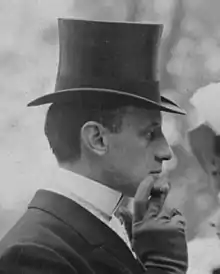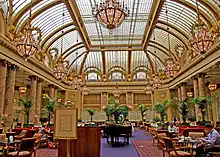Goodhue Livingston | |
|---|---|
 Livingston in 1906 | |
| Born | February 23, 1867 New York City, U.S. |
| Died | June 3, 1951 (aged 84) Southampton, New York, U.S. |
| Alma mater | Columbia University |
| Occupation | Architect |
| Spouse | Louisa Robb |
| Partner(s) | Stockton B. Colt; Breck Trowbridge |
| Children | 2 |
| Awards | Medal of Honor, Architectural League of New York |
| Practice | Trowbridge & Livingston Trowbridge, Colt & Livingston |
| Buildings | Hayden Planetarium Palace Hotel St. Regis Hotel Oregon State Capital |
Goodhue Livingston (February 23, 1867 – June 3, 1951) was an American architect who co-founded the firm of Trowbridge & Livingston.[1][2] He designed the St. Regis Hotel, the Hayden Planetarium, and numerous buildings listed on the National Register of Historic Places.[1][3]
Early life
Livingston was born in New York City.[1] He was the son of Susan Maria Clarkson de Peyster (1823 – 1910) and Robert Edward Livingston (1820 – 1889), who inherited wealth and did not work.[2][1][4] His paternal grandfather was Edward Philip Livingston, the 11th Lieutenant Governor of New York.[5] His paternal great-grandfather, Philip R. Livingston, was a signatory of the Declaration of Independence and member of the first Continental Congress.[4]
Livingston attended Columbia University, receiving an A.B. in 1888, a Ph.B. in architecture 1892, and an MA in 1914.[1] While there, he joined the Fraternity of Delta Psi (St. Anthony Hall).[6] He also participated in Columbia's Dramatic Club.[7][8]
Career

In 1894, Livingston co-founded Trowbridge, Livingston & Colt in New York City along with Stockton B. Colt and Samuel Breck Parkman Trowbridge.[9][10] Colt and Livingston were fraternity brothers, and all three attended Columbia University together.[6][10] When Colt left the firm in 1897, its name changed to Trowbridge & Livingston.[9]
Trowbridge & Livingston became known for its commercial, institutional, and public buildings, many in Beaux Arts or Neoclassical architectural styles.[10][11] Often commissioned by well-heeled clients, the firm's work was especially prevalent in the Upper East Side and Wall Street precincts of New York City.[11]
One of Livingston's early commissions was the Ardsley Club (1896), designed for its founding members including J. P. Morgan, John D. Rockefeller, William Rockefeller Jr., and Cornelius Vanderbilt II.[12]
In New York City, Livingston designed the Renaissance Revival style B. Altman and Company Building (1905), the Neo-Classical style Bankers Trust Company Building (1912), the Chemical National Bank Building (1907), Rikers Island Penitentiary, and the Baroque style St. Regis Hotel (1904).[13][1][14][15][16] The firm acquired the contract for the St. Regis from John Jacob Astor IV through a design contest.[11] The hotel was "hailed in the press not just for its architectural and technological brilliance, but for what one columnist characterized as its role in shaping the face and style of New York.”[11]
He also designed the interior of The Knickerbocker Hotel in 1906 and an addition for the New York Stock Exchange in 1923.[1][13] In 1935, Livingston designed the Hayden Planetarium for the American Museum of Natural History in New York City.[10]
In Pittsburgh, Pennsylvania, he designed the United States Post Office & Courthouse (aka the Joseph F. Weis, Jr. U.S. Courthouse) in 1931 and the Gulf Building or Gulf Tower in 1932; the latter with the architect Edward Mellon[1][3] He was the architect for the Mitsui Bank and Trust Company of Tokyo and the Palace Hotel in San Francisco (1909).[1][9] He also designed the Oregon State Capital (1938) in Salem with architect Francis Keally.[3][9]
He retired in 1946.[1]
Professional affiliations
Livingston was a member of the Architectural League of New York, and the National Institute of Social Sciences.[1] He was a fellow of the American Institute of Architects.[1]
Livingston received the Medal of Honor from the Architectural League of New York.[1]
Personal


Livingston married Louisa Robb (1877 – 1960) on April 8, 1896, at St. George’s Episcopal Church in New York City.[17][11][2] She was the daughter of Cornelia Van Rensselaer (née Thayer) and James Hampden Robb, a banker, cotton merchant, New York City Parks Commissioner, and New York State Senator.[18][11][2]
Together, they were the parents of Goodhue Livingston Jr. (born 1897) and Cornelia Thayer Livingston (born 1903).[2] In 1912, Livingston was charged with mismanagement of his children's trust funds of $120,000 each.[19] It was claimed that Livingston had invested some of the funds in stock rather than securities as required by law.[19]
The family lived at 38 East 65th Street in New York City.[11] They also had a summer home in Southampton, Long Island, New York that was designed by Livingston.[11] The Southampton property was located on ten acres beside The Dolphins, Louisa's childhood summer home.[11] Livingston designed their Georgian Revival mansion "Old Trees" with gardens, stables, and service buildings. The name was derived from the landscaped ground's many trees.[11] At Old Trees, the family had a butler, gardeners, maids, and other servants to allow them to entertain high society and maintain the large estate.[11] Louisa noted, "Southampton has footmen, but we’ve never had footmen in knee britches.”[11] However, the era of the footmen ended with World War II, when just their butler remained.[11]
In 1922, burglars stole $20,000 in jewelry from Oak Trees while the Livingstons were entertaining there; most of the stolen jewelry was an heirloom.[20]
Livingston was a trustee of the New York Dispensary.[1] He was a founder of the National Golf Links of America and was also a president and member of the Meadow Club, a president and member of the Southampton Golf Club, and member of the Shinnecock Hills Golf Club.[1]
He served on the board of governors of The Brook Club and was a member of the Century Association, the Knickerbocker Club, the Masons, the Racquet and Tennis Club, and the St. Anthony Club of New York.[1]
In 1951, Livingston died of a heart ailment at the Southampton Hospital in Southampton, New York.[1] At the time, his residence was 720 Park Avenue in New York City.[1]
References
- 1 2 3 4 5 6 7 8 9 10 11 12 13 14 15 16 17 18 "G. Livingston Dies; Long an Architect; Practitioner Here for 50 Years Included Hayden Planetarium, Oregon Capitol in His Work" (PDF). The New York Times. June 4, 1951. p. 26. Retrieved June 6, 2017.
- 1 2 3 4 5 Van Rensselaer, Florence (1949). The Livingston family in America and its Scottish Origins. New York, New York: Florence Van Rensselaer and The William Byrd Press. p. 209. hdl:2027/wu.89082383134. Retrieved April 22, 2022 – via Hathi Trust.
- 1 2 3 "National Register Information System". National Register of Historic Places. National Park Service. July 9, 2010.
- 1 2 "Robert Edward Livingston". Poughkeepsie Eagle-News (Poughkeepsie, New York). January 24, 1889. p. 8. Retrieved April 22, 2022 – via Newspapers.com.
- ↑ Livingston, Edwin Brockholst (1910). The Livingstons of Livingston Manor: Being the History of that Branch of the Scottish House of Callendar which Settled in the English Province of New York During the Reign of Charles the Second; and Also Including an Account of Robert Livingston of Albany, "The Nephew," a Settler in the Same Province and His Principal Descendants. Knickerbocker Press. Retrieved April 18, 2017.
- 1 2 Meyer, H. L. G. Catalog of the Members of the Fraternity of Delta Psi Revised and Corrected to July 1906. New York: Fraternity of Delta Psi, 1906 via Google Books
- ↑ "An Amateur Dramatic Entertainment". The New York Times. February 3, 1886. p. 5. Retrieved April 22, 2022 – via Newspapers.com.
- ↑ "The Columbia University Dramatic Club". The New York Times. April 10, 1888. p. 2. Retrieved April 22, 2022 – via Newspapers.com.
- 1 2 3 4 Michelson, Alan. "Trowbridge and Livingston, Architects". Pacific Coast Architecture Database (PCAD. Washington University. Retrieved April 22, 2022.
- 1 2 3 4 "Trowbridge and Livingston". NYC Architecture. Retrieved April 22, 2022.
- 1 2 3 4 5 6 7 8 9 10 11 12 13 Cummings, Mary (December 18, 2020). "High Style in the Gilded Age: Louisa Robb Livingston". Southampton History Museum. Retrieved April 22, 2022.
- ↑ Rosenberg, Merri (July 2, 1995). "Ardsley Country Club Marks 100th Year". The New York Times. Retrieved September 28, 2016.
- 1 2 White, Norval; Willensky, Elliot; Leadon, Fran (2010). AIA Guide to New York City (5th ed.). New York: Oxford University Press. ISBN 978-0-19-977291-9.
- ↑ "The B. Altman Department Store". NYC Architecture. Retrieved April 22, 2022.
- ↑ "St.Regis-Sheraton Hotel". NYC Architecture. Retrieved April 22, 2022.
- ↑ "Bankers Trust Company Building". NYC Architecture. Retrieved April 22, 2022.
- ↑ The New York Genealogical and Biographical Record. New York Genealogical and Biographical Society. 1880. p. 155. Retrieved April 18, 2017.
- ↑ "Mrs. Goodhue Livingston Dies; Aided Civic and Charity Causes". The New York Times. January 17, 1960. Retrieved January 9, 2018.
- 1 2 "Cites Goodhue Livingston" (PDF). The New York Times. July 11, 1917. p. 8. Retrieved April 22, 2022.
- ↑ "Burglars Get $20,000 in Southampton House" (PDF). The New York Times. May 31, 1922. p. 35. Retrieved April 22, 2022.
